
The orbicular batfish, also known as the cooper batfish, circular batfish, orbiculate batfish, round batfish, narrow-banded batfish or orbic batfish is a species of marine ray-finned fish belonging to the family Ephippidae, the spadefishes and batfishes. This species is found in the Indo-Pacific but has been recorded outside its native range in the western Atlantic Ocean.

Ephippidae is a family of percomorph fishes, the spadefishes, in the order Moroniformes. These fishes are found in the tropical and temperate oceans of the world, except for the central Pacific.
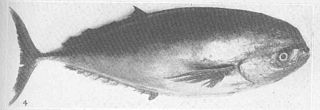
The louvar or luvar is a species of marine ray-finned fish, it is the only extant species in the genus Luvarus and family Luvaridae. This taxon is classified within the suborder Acanthuroidei, which includes the surgeonfish, of the order Acanthuriformes, and is the only pelagic species of this order. The juvenile form has a pair of spines near the base of the tail, like the surgeonfish, though they are lost in the adult.

The French angelfish is a species of marine ray-finned fish, a marine angelfish belonging to the family Pomacanthidae. It occurs in the Western Atlantic Ocean.
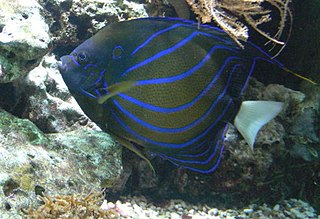
The bluering angelfish, also known as the annularis angelfish and the blue king angelfish, is a species of marine ray-finned fish, a marine angelfish belonging to the family Pomacanthidae. It is member of the genus Pomacanthus, composed of large marine angelfish.

Holacanthus bermudensis, also known as the blue angelfish or Bermuda blue angelfish, is a species of ray-finned fish, a marine angelfish belonging to the family Pomacanthidae. It occurs in the western Atlantic Ocean.
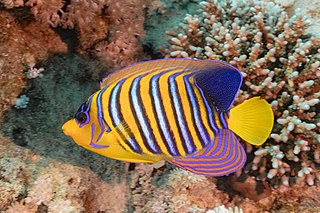
The royal angelfish, or regal angelfish, is a species of marine ray-finned fish, a marine angelfish belonging to the family Pomacanthidae, and the monotypic genus Pygoplites. It is found in tropical Indo-Pacific oceans. It can grow as long as 25 cm (9.8 in).

The rock beauty, also known as corn sugar, coshubba, rock beasty, catalineta, and yellow nanny, is a species of marine ray-finned fish, a marine angelfish belonging to the family Pomacanthidae. It is found in the western Atlantic Ocean.

The gray angelfish, also written as grey angelfish and known in Jamaica as the pot cover, is a species of marine ray-finned fish belonging to the marine angelfish family, Pomacanthidae. It is found in the Western Atlantic Ocean.

Platax pinnatus, also known as the longfin batfish, pinnate spadefish, pinnate batfish, pinnatus batfish, dusky batfish, shaded batfish, or red-faced batfish is a species of marine ray-finned fish belonging to the family Ephippidae, the spadefishes and batfishes. This species is found in the western Pacific Ocean and occasionally is kept in marine aquariums.
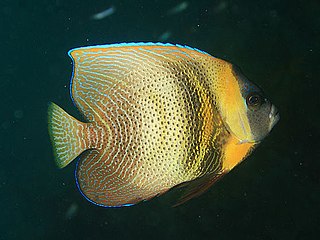
Pomacanthus zonipectus, the Cortez angelfish, is a species of marine ray-finned fish, a marine angelfish belonging to the family Pomacanthidae. It is from the Eastern Pacific. It occasionally makes its way into the aquarium trade.

The snake mackerel is the sole species of fish in the monotypic genus Gempylus, belonging to the family Gempylidae. It is found worldwide in tropical and subtropical oceans between the latitudes of 42°N and 40°S; adults are known to stray into temperate waters. It is found to a depth of 600 meters. Populations of the snake mackerel from the Atlantic and the Indo-Pacific differ in vertebral count and number of first dorsal fin spines, and so may represent separate species.

The deepbody boarfish, or robust deepsea boarfish, is a species of marine ray-finned fish belonging to the family Caproidae, the boarfishes. This fish is found in the warmer waters of the Atlantic, Indian and Pacific Oceans.
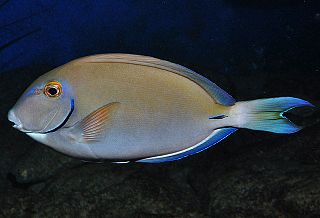
Acanthurus tractus, the five-band surgeonfish, ocean surgeon, or ocean surgeonfish, is a species of ray-finned fish in the family Acanthuridae found in the western Atlantic Ocean, Florida, the Bahamas, the Caribbean Sea and the Gulf of Mexico. Until recently, it was considered a synonym of Acanthurus bahianus, but its status as a separate species was resurrected in 2011.

Chaetodipterus is a genus of marine ray-finned fishes belonging to the family Ephippidae, the spadefishes. These fishes are found in the Atlantic and eastern Pacific Oceans.
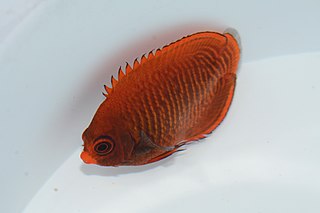
Golden angelfish, also known as golden pygmy angelfish or velvet dwarf angel, is a small marine ray-finned fish, a marine angelfish belonging to the family Pomacanthidae. It inhabits shallow reefs in the western Pacific Ocean.

Centropyge shepardi, the mango angelfish, Shepard’s angelfish or Shepard’s pygmy angelfish, is a species of marine ray-finned fish, a marine angelfish belonging to the family Pomacanthidae. It is found in the Western Pacific Ocean.

The Clarion angelfish is a species of marine ray-finned fish, a marine angelfish belonging to the family Pomacanthidae. It is found in the eastern Pacific Ocean, almost exclusively near islands off the Pacific coast of Mexico.

The spotbanded scat,(Selenotoca multifasciata), also known as the striped scat, banded scat, barred scat, butterfish, John Dory, Johnny Dory, old maid, Southern butter-fish or striped butterfish, is a species of ray-finned fish, belonging to the family Scatophagidae, the scats. They are found in the eastern Indian Ocean and southwestern Pacific Ocean.
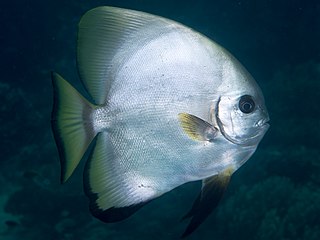
Platax boersii, the golden spadefish or Boers’ batfish, is a species of marine ray-finned fish belonging to the family Ephippidae, the spadefishes and bay fishes. This species is found in the Indo-West Pacific.























